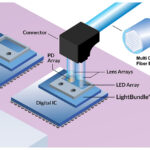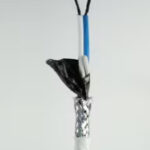The use of digital twins can be an important factor in maximizing the performance and flexibility of Industry 4.0 factories. Open Platform Communications (OPC) is the interoperability standard for the secure and reliable exchange of data in industrial automation environments. OPC has been expanded to include the unified architecture (UA), standardized as IEC 62541, that includes the possibility of integrating digital twins of every device in a factory, including connectors.
This FAQ begins with a definition of digital twins and how they can be integrated into Industry 4.0 factories. It then looks at an example of a smart electrical connector (SmEC) that brings digital twin functionality to industrial installations. It closes by briefly looking at how OPC UA PubSub data and an asset administration shell (AAS) in the cloud are used to implement the SmEC.
A digital twin is a virtual representation of a physical object or system. It integrates all data, simulation models, testing, and other information from a physical object generated during engineering, commissioning, operation, and service through end-of-life. A digital twin is not a generic representation; it’s specifically tied to an individual device, like a single connector, and tracks its design, production, and use throughout its entire lifecycle.
Digital twins can provide near real-time tracking and analysis of operations on the factory floor down to individual machines, sensors, and components like connectors, and supports improved analytics, process flexibility, and higher quality.
At Hannover Fair 2023, together with Microsoft (cloud services provider), SAP (software and data evaluation), and Siemens (as a user), HARTING demonstrated an SmEC that leverages OPC UA in the physical connector, OPC UA Pub/Sub data, and an AAS in the cloud to support integration as a digital twin into a virtual factory (Figure 1). The connector records operational process and condition data over its entire life cycle.

The connector status is communicated in near real time using OPC UA to the digital twin in the cloud and can be used for actively monitoring factory processes. The availability of connection data, including voltage and current, makes it easy to monitor the status of the connected machine. In addition, three connector states are monitored:
- Unplugged
- Plugged in and locked in place without load
- Plugged in and locked in place under load
The connector’s digital twin includes data like the number of mating/unmating cycles and can be integrated with other data about the factory environment, like the ambient temperature and humidity, through the factory digital twin. That information can be used to schedule preventative maintenance, avoiding downtime and boosting productivity.
Pub/Sub communication
The Pub/Sub communication protocol in OPC UA is not based on a client-server structure. OPC UA clients supporting Pub/Sub can be a Publisher that sends data or a Subscriber that receives data. The system must include a “broker” that can receive data from publishers and deliver data to subscribers (Figure 2). In applications like Industry 4.0 factories with large numbers of publishers and subscribers, Pub/Sub is much more efficient than direct sender-receiver connectivity. OPC UA Pub/Sub is transport-independent and can be carried over user datagram protocol (UDP) or message queuing telemetry transport (MQTT), depending on the application requirements.

Asset administration shells
The Industrial Digital Twin Association (IDTA), the developer of the AAS, is currently standardizing the AAS specification as part of IEC 62378. The AAS is the key element supporting the development of a connector digital twin. The demonstration at the Hannover Fair showed how the content is accumulated in the AAS. First, the connector maker provisions the SmEC’s AAC with basic manufacturing data and, in this case, leveraging Siemens’ NX CAD design-to-manufacturing system. In the next step, the connector is installed in a specific machine. Finally, the machine is installed in a factory. The SmEC sends the digital twin its serial number and other identifying data, connectivity status, applied power measurements, and identification of the mating socket. In the demonstration, the data was sent to the Microsoft Azure cloud, where the Azure Digital Twin and Azure Data Explorer services were used for analytics.
Summary
OPC UA Pub/Sub data can be sent from a connector with an embedded AAS to support the implementation of the connector’s digital twin in an Industry 4.0 factory. The digital twin resides in the cloud and can be used to support near real-time analytics, schedule preventative maintenance, and provide the information needed for continuous process improvement.
References
Industrial Digital Twin Association
Industrial Interoperability with OPC UA and the AAS, OPC Foundation
Smart Electrical Connector, Harting
The Asset Administration Shell: Impleamenting Digital twins for use in Industrie 4.0, Platform Industrie 4.0
Use-Cases for OPC UA Methods, Pub/Sub, & Companion Specs, OPC Foundation





Leave a Reply
You must be logged in to post a comment.